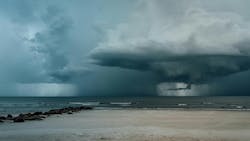Existential Threats and What Engineers Can Actually Do
Existential is a word that we hear bandied about a great deal these days. One can rarely read or listen to a news story about climate change without seeing or hearing it referred to as an “existential threat.” Many others use the term to amplify the seriousness of their pet issue, whatever it may be.
According to Dictionary.com, "existential" is an adjective “relating to existence, especially human existence.” Based on science, not politics, there is no doubt that the long-term effects of anthropogenic climate change, if unchecked, will ultimately be disastrous for life on this planet. So it clearly meets the definition of an existential threat. It is not, however, the only threat to our civilization. Nor is it, necessarily, the most serious threat, at least not in the short term.
Many politicians and pundits would have you believe that climate change is more dangerous than the lunatic who leads North Korea and has, according to the Arms Control Association, 30 nuclear warheads ready to launch and enough material to build another 50-70 weapons. That to me, in addition, to Pyongyang’s chemical and biological weapons programs, seems to be a more imminent threat to humanity than climate change. The Russian invasion of Ukraine also poses a threat to the world, since Russian President Putin and his spokespeople keep sword rattling swords with not-so-subtle threats about the use nuclear weapons against those – particularly NATO members – helping Ukraine.
And given the volatility of the Middle East right now, we don’t even want to consider what happens when Iran finally achieves their goal of having an arsenal of nuclear weapons! Unfortunately, this kind of hyperbole is also how politicians and the media seriously impede the efforts of scientists and sustainability advocates to convince the general public of the reality and severity of the threats posed by climate change.
But there is a big difference between all of these very real threats.
Other than electing leaders to the White House and Congress who will protect America (and, by inference, the rest of the world) from madmen with weapons, there is very little that HPAC Engineering readers can do to ameliorate our fear of nuclear war.
However, they can help reduce the activities that produce the greenhouse gases (GHGs) that result in climate change. But first, we need to filter out the rhetoric from the politicians who totally deny the scientific evidence of anthropogenic climate change.
According to NASA, the effects of increasing GHG emissions since the Industrial Revolution have resulted in a 50% increase in atmospheric CO2 emissions. That is, the CO2 levels in our atmosphere today are 150% of what they were in 1750 or so, less than 300 years ago. And there is no disputing the effect that heat-trapping GHGs have on the Earth’s temperatures.
It's time for both sides of the political spectrum to drop their self-serving agendas and to provide policies that will lead to reasonable and meaningful solutions to climate change. Rational and irrational fears will always be out there. But when we have the ability to actually solve some of these problems, we must finally find the will to act. And action will even make us feel better.
##########
A regular contributor to HPAC Engineering and a member of its editorial advisory board, the author is a principal at Sustainable Performance Solutions LLC, a south Florida-based engineering firm focusing on energy and sustainability. He can be reached at [email protected].
About the Author
Larry Clark
A member of HPAC Engineering’s Editorial Advisory Board, Lawrence (Larry) Clark, QCxP, GGP, LEED AP+, is principal of Sustainable Performance Solutions LLC, a South Florida-based engineering firm focused on energy and sustainability consulting. He has more than two dozen published articles on HVAC- and energy-related topics to his credit and frequently lectures on green-building best practices, central-energy-plant optimization, and demand-controlled ventilation.
